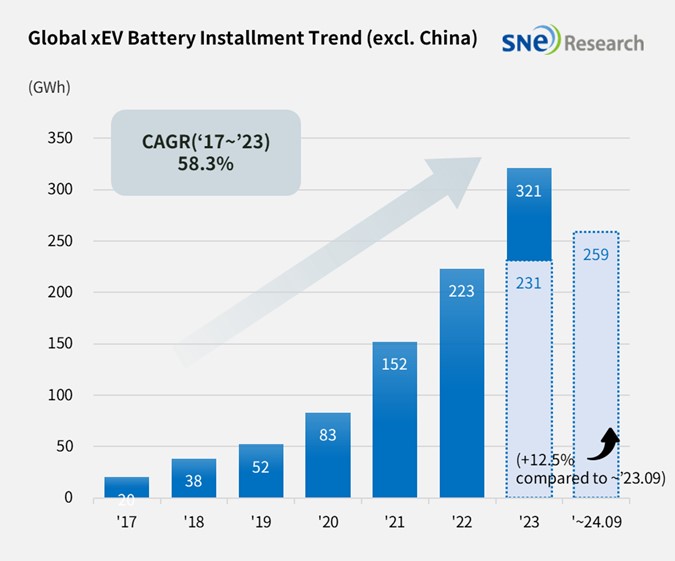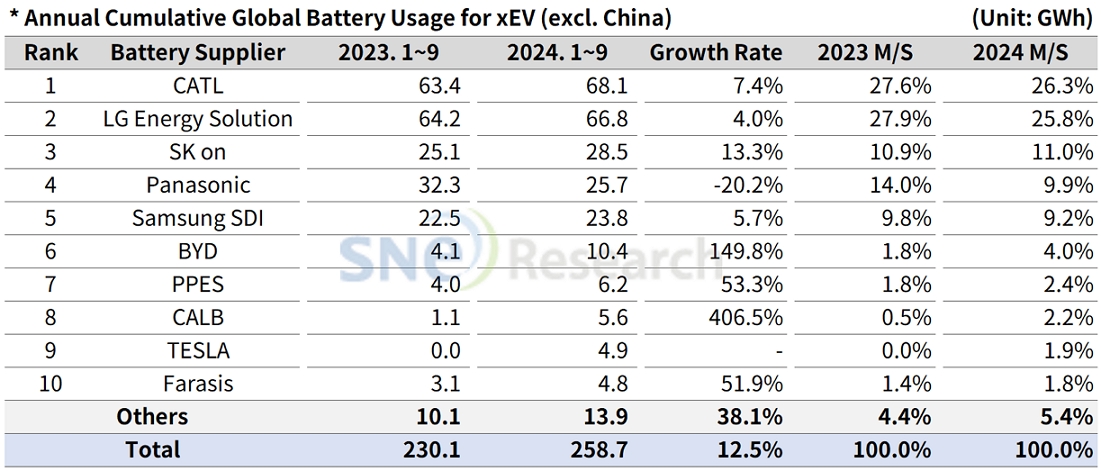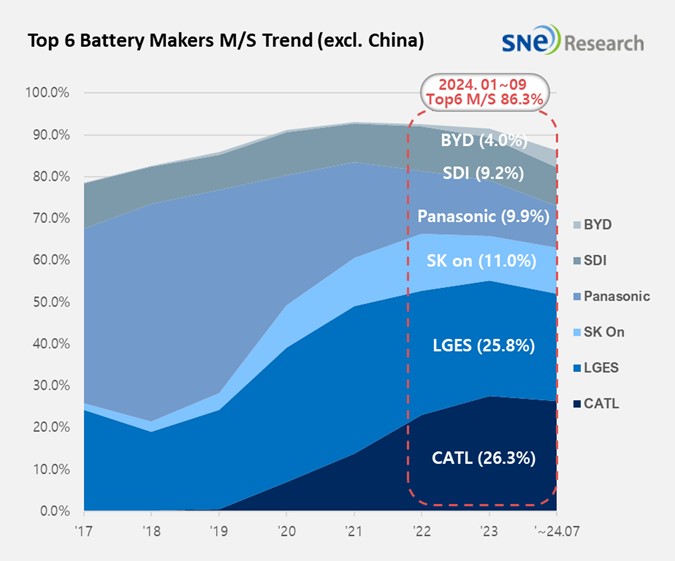From Jan to Sept 2024, Non-Chinese Global[1] EV Battery Usage[2] Posted 258.7GWh, a 12.5% YoY Growth
- K-trio’s combined M/S recorded 46.0% from Jan to Sept 2024
Battery installation for
global electric vehicles (EV, PHEV, HEV) excluding the Chinese market sold from
January to September in 2024 was approximately 258.7GWh, a 12.5% YoY growth.

(Source: Global EV and Battery Monthly Tracker – Oct 2024, SNE Research)
The combined usage of batteries made by the K-trio companies for electric vehicles from January to September 2024 was higher than that from the same period of last year. LG Energy Solution kept the 2nd place in the ranking with a 4.0%(66.8GWh) YoY growth, while SK On ranked 3rd with a 13.3%(28.5GWh) YoY growth. Samsung SDI posted the highest YoY growth, 5.7%(23.8GWh), among the K-trio companies. On the other hand, the combined market shares of K-trio were 46.0%, declined by 2.6%p compared to the same period of last year.

(Source: Global EV and Battery Monthly Tracker – Oct 2024, SNE Research)
If we look at the usage of battery made by the K-trio in terms of the sales volume of models, Samsung SDI showed a favorable growth thanks to solid sales of BMW and Rivian. Other than these, Audi Q8 e-Tron and JEEP Wranlger PHEV continuously sold well.
SK On saw a growth in the usage of its battery based on sales of Hyundai Motor Group, Mercedes, Ford and Volkswagen. Despite a slowdown in sales earlier this year, Hyundai’s IONIQ 5, EV6, and EV9; Mercedes Benz EQA and EQB; and Ford F-150 Lightning showed a recovery in sales, registering the highest growth among the K-trio battery suppliers.
LG Energy Solution stayed in an upward trend in the usage of its battery as EV models popular in Europe and North America – Tesla Model 3/Y, VW ID.4, Ford Mustang Mach-E, and GM Cadillac LYRIQ – showed solid sales in those regions. Other than these, the sales of Hyundai IONIQ 6 and KONA Electric in Europe, to which LG Energy Solution’s battery is installed, significantly increased compared to the same period of last year.
Panasonic, the only Japanese company in the top 10 on the list, recorded 25.7GWh from January to September this year, ranked 4th on the list but recording a 20.2% YoY degrowth. The major reason for Panasonic’s degrowth was a slowdown in sales of Tesla Model 3 due to its transformation to the facelifted version earlier this year. As sales of Model 3 have recently expanded and Panasonic was reported to launch advanced 2170 and 4680 cells supplied to Tesla, Panasonic is expected to rapidly regain its market share mainly focusing on Tesla.
CATL accounted for the biggest market share in the non-China global market with a 7.4%(68.1GWh) YoY growth. Currently, major global OEMs such as Tesla, BMW, Mercedes, Volkswagen, and Hyundai Motor Group adopt CATL’s battery for their electric vehicles. In order to address the oversupply issue in the Chinese domestic market, CATL turned their eyes to overseas markets such as Brazil, Thailand, Israel, and Australia, leading to an expectation that it would rapidly expand its market share around the globe.

(Source: Global EV and Battery Monthly Tracker – Oct 2024, SNE Research)
In the non-China market, BYD has been showing an intimidating growth by rapidly expanding the export of vehicles with high price competitiveness to newly emerging countries such as Brazil and Thailand. To dominate the emerging markets, BYD has a plan to build its electric vehicle production plants in Hungary, Pakistan, Turkey, and Thailand. Many other Chinese makers are also trying to build their presence in the emerging markets in response to trade barriers. As global OEMs have been adopting LFP battery for their vehicles and establishing their plans to increasingly adopt LFP battery in future, it has become more importance for the K-trio to move up the LFP mass production time like other Chinese counterparts.
[2] Based on battery installation for xEV registered during the relevant period.

